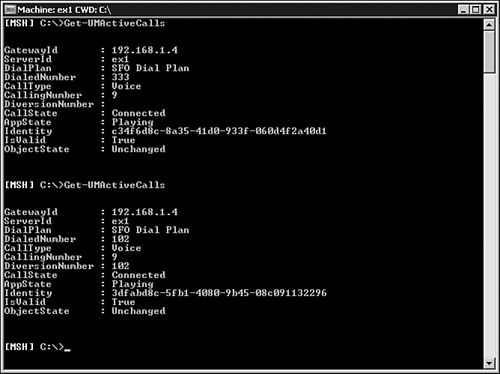A number of tools are built
in to the Exchange 2007 unified messaging platform to support the
troubleshooting and monitoring of the services.
First and foremost, it is
highly recommended that administrators deploy Microsoft Operations
Manager (MOM) 2005 to monitor the Exchange 2007 infrastructure. There is
a management pack specific to the Exchange 2007 platform with a wealth
of knowledge built in.
That
said, it is still important for the Exchange administrator to have a
good knowledge and familiarity with the tools that are available to
monitor Exchange 2007 unified messaging. These tools include the
following:
Exchange Management Shell test cmdlets
Performance Monitor objects and counters
Event log messages
Removing the first UM server
These tools and techniques are covered in the next sections.
Active Calls
The system can provide
information on active calls, which is very useful for monitoring and
troubleshooting the unified messaging system. The Get-UMActiveCalls
cmdlet returns information about the calls that are active and being
processed by the Unified Messaging (UM) server. The syntax for the
cmdlet is given in Table 1.
Table 1. Get-UMActiveCalls cmdlets
| Syntax |
|---|
| Get-UMActiveCalls [-Server <ServerIdParameter>] |
| Get-UMActiveCalls -InstanceServer <UMServer> |
| Get-UMActiveCalls -DialPlan <UMDialPlanIdParameter> |
| Get-UMActiveCalls -IPGateway <UMIPGatewayIdParameter> |
Figure 1
shows two instances of the command. In the first execution of the
command, it shows an active call with the DialedNumber of 333,
indicating that it has come in via the subscriber access line configured
in the example installation. In the second execution of the command, it
shows that the caller has dialed extension 102.

Connectivity
Connectivity to the IP/VoIP
gateway can be one of the most troublesome aspects of the deployment
and support of a unified messaging system. The Test-UMConnectivity
cmdlet can be used to test the operation of a computer that has the
Unified Messaging server role installed. The syntax for the cmdlet is
given in Table 2.
Table 2. Test-UMConnectivity cmdlet
| Syntax |
|---|
| test-UMConnectivity
[-Fax <$true | $false>] [-ListenPort <Int32>]
[-MonitoringContext <$true | $false>] [-Secured <$true |
$false>] [-Timeout <Int32>] |
| test-UMConnectivity
-IPGateway <UMIPGatewayIdParameter> -Phone <String> [-Fax
<$true | $false>] [-ListenPort <Int32>] [-MonitoringContext
<$true | $false>] [-Secured <$true | $false>] [-Timeout
<Int32>] |